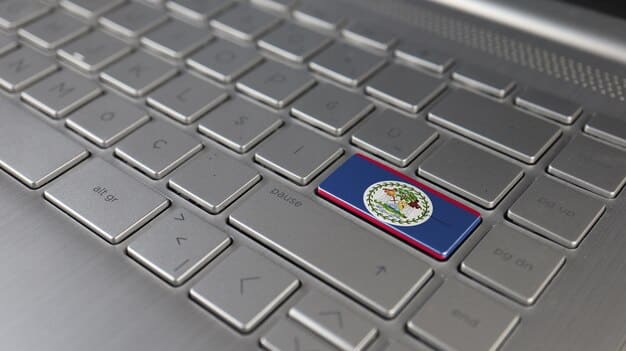Unclaimed Tax Refunds: A Guide to Getting Your Money Back

Don’t leave money on the table; unclaimed tax refunds in the US represent rightful funds waiting to be claimed by eligible taxpayers, and this guide provides essential steps and resources to help you recover what’s yours.
Are you among the millions of Americans who might be missing out on unclaimed tax refunds? Don’t Leave Money on the Table: A Guide to Unclaimed Tax Refunds in the US shows you how to discover and claim your potentially forgotten funds.
Understanding Unclaimed Tax Refunds
Unclaimed tax refunds occur when taxpayers overpay their taxes either through excessive withholding or by failing to claim eligible credits. These refunds remain unclaimed because the IRS might not have a current address for the taxpayer or because the taxpayer simply forgets to file a return.
It’s essential to understand how these refunds accumulate and the different scenarios that can lead to money being left unclaimed. Knowing this helps taxpayers be proactive in checking for potential refunds.
Common Reasons for Unclaimed Refunds
Several situations can cause tax refunds to go unclaimed. Here are some of the most common:
- Incorrect Addresses: Moving without updating your address with the IRS is a primary reason. If the IRS sends a refund check to a previous address, it will likely go uncashed.
- Unfiled Tax Returns: Sometimes people don’t file their tax returns because they think they don’t owe taxes or are unsure how to proceed. However, even if you don’t owe, you might be eligible for a refund.
- Forgotten Credits or Deductions: Taxpayers might miss out on claiming eligible credits or deductions, resulting in an overpayment that leads to a refund.
- Life Changes: Major life events such as marriage, divorce, or the birth of a child can affect your tax obligations and potential refunds.
The IRS’s Role in Handling Unclaimed Refunds
The IRS plays a crucial role in managing unclaimed refunds. The agency holds on to these funds, waiting for taxpayers to claim them. While the IRS makes some effort to locate taxpayers, it’s ultimately the taxpayer’s responsibility to initiate the claim process.
The IRS typically holds unclaimed refunds for up to three years. After this period, the funds become property of the U.S. Treasury. Therefore, quick action is essential if you suspect you have an unclaimed refund.
In conclusion, understanding the dynamics of unclaimed refunds and the IRS’s role can motivate taxpayers to take necessary steps and reclaim their money promptly.
How to Check for Unclaimed Tax Refunds
Finding out if you have unclaimed tax refunds involves a straightforward process. By using the IRS’s online tools and following specific procedures, you can quickly check for any unclaimed money.
The IRS provides several resources to help taxpayers determine if they are owed a refund. Utilizing these resources can save you time and potentially put money back in your pocket.

Using the IRS Online Tool
One of the easiest ways to check for unclaimed tax refunds is by using the IRS’s online tool, “Where’s My Refund?” This tool allows you to track the status of your refund using your Social Security number, filing status, and the exact amount of your refund.
To use the tool, follow these steps:
- Visit the IRS website and navigate to the “Where’s My Refund?” tool.
- Enter your Social Security number or Individual Taxpayer Identification Number (ITIN).
- Select your filing status (Single, Married Filing Jointly, Head of Household, etc.).
- Enter the exact refund amount you claimed on your tax return.
Checking Amended Returns
If you filed an amended tax return, you can also check its status online. The IRS provides a separate tool specifically for tracking amended returns, which typically take longer to process than original returns.
To check the status of your amended return:
- Go to the IRS website and find the “Where’s My Amended Return?” tool.
- Enter your Social Security number or ITIN.
- Provide your date of birth.
- Enter your zip code.
In summary, using the IRS’s online tools and checking amended returns are practical ways to discover if you have unclaimed tax refunds. Regular checks can help ensure you receive any money owed to you promptly.
Steps to Claim Your Unclaimed Tax Refund
Once you’ve identified that you have an unclaimed tax refund, the next step is to claim it. This process usually involves filing the necessary tax returns and providing the correct information to the IRS.
Claiming your unclaimed tax refund is essential to ensuring you receive the money that rightfully belongs to you. Here’s a detailed guide to help you through the process.
Filing the Necessary Tax Returns
To claim your unclaimed tax refund, you need to file the relevant tax return with the IRS. If you didn’t file a return for the year in question, you’ll need to complete and submit one.
Here’s what you need to do:
- Gather all necessary documents, such as W-2 forms, 1099 forms, and any other relevant financial records.
- Complete Form 1040, U.S. Individual Income Tax Return, for the tax year in question. You can download this form from the IRS website.
- Fill out all required sections accurately and include any eligible deductions or credits.
- Submit the completed tax return to the IRS either electronically or by mail.
Providing the Correct Information
Ensuring that you provide the correct information to the IRS is critical for a smooth and timely refund process. Double-checking your details can prevent delays or complications.
Here are some tips:
- Verify your Social Security number or ITIN for accuracy.
- Ensure your name matches the one on your Social Security card.
- Provide your current mailing address to ensure the refund check is sent to the correct location. Update your address with the IRS if needed.
- Include all necessary schedules and forms to support your tax return.
Dealing with Expired Refund Checks
If you receive a refund check that has expired, you can request a replacement from the IRS. The IRS typically issues refund checks that are valid for one year from the date of issue.
To request a replacement:
- Write “Void” across the front of the expired check.
- Send the voided check along with a written explanation requesting a replacement to the appropriate IRS address.
- Include your name, current address, Social Security number, the tax year, and the reason for the replacement request.
In conclusion, claiming your unclaimed tax refund involves filing the necessary tax returns, providing accurate information, and knowing how to handle expired refund checks. Following these steps helps ensure a successful claim.

Understanding the Statute of Limitations
The statute of limitations is a critical factor to consider when dealing with unclaimed tax refunds. It sets a time limit on how long you have to claim a refund, and missing this deadline means losing the right to claim the money.
Understanding these timelines can help you avoid missing out on potential refunds and encourage timely action.
The Three-Year Rule
The IRS generally allows taxpayers three years from the date they filed their tax return to claim a refund. If you file your tax return late, the three-year period begins from the date the IRS received your return.
Here’s an example:
- If you filed your 2020 tax return on April 15, 2021, you have until April 15, 2024, to claim a refund for that year.
Exceptions to the Rule
There are certain exceptions to the three-year rule, which can extend the time you have to claim a refund. These exceptions typically apply to specific circumstances, such as:
- Disability: If a taxpayer is financially disabled and unable to manage their financial affairs, the statute of limitations may be suspended.
- Military Service: Members of the military serving in a combat zone or hazardous duty area may have an extended time to file and claim a refund.
- Federally Declared Disaster: In the event of a federally declared disaster, the IRS may extend the filing and refund claim deadlines for affected taxpayers.
Importance of Timely Action
Given the strict deadlines imposed by the statute of limitations, timely action is crucial. Waiting too long to file and claim a refund can result in forfeiting your right to the money.
Here are some reasons to act promptly:
- Avoid losing your refund permanently.
- Ensure you receive your money when you need it.
- Simplify the process by having access to relevant documents and information while they are still readily available.
In summary, understanding the statute of limitations and acting promptly are essential for successfully claiming unclaimed tax refunds. Knowing the deadlines and exceptions can help taxpayers effectively manage their tax affairs.
Common Mistakes to Avoid
Claiming unclaimed tax refunds can be a straightforward process, but several common mistakes can lead to delays or denials. Being aware of these pitfalls can help you navigate the process more effectively.
Avoiding these errors ensures a smoother experience and increases your chances of successfully claiming your refund.
Incorrect Filing Status
One of the most common mistakes is using the wrong filing status. Your filing status affects your standard deduction, tax brackets, and eligibility for certain credits and deductions.
Here’s why it’s important to get it right:
- Single: For unmarried individuals who do not qualify for another filing status.
- Married Filing Jointly: For married couples who agree to file a single return together.
- Married Filing Separately: For married individuals who choose to file separate returns, often for specific financial or legal reasons.
- Head of Household: For unmarried individuals who pay more than half the costs of keeping up a home for a qualifying child.
- Qualifying Widow(er) with Dependent Child: For individuals who meet certain criteria following the death of their spouse.
Missing Documentation
Failing to include all necessary documentation can also delay or complicate the refund process. The IRS requires specific forms and schedules to support your tax return and refund claim.
Commonly missed documents include:
- W-2 forms from employers
- 1099 forms for income from sources other than employment
- Receipts for deductible expenses
- Schedules for claiming credits or deductions
Math Errors
Simple math errors can also cause issues with your tax return and refund claim. Even small mistakes can lead to discrepancies that the IRS will flag.
Tips to avoid math errors:
- Use tax preparation software to automatically calculate figures.
- Double-check all calculations before submitting your return.
- Have a friend or family member review your return for accuracy.
In short, avoiding common mistakes such as incorrect filing status, missing documentation, and math errors is crucial for a smooth and successful claim process. Taking the time to review your tax return carefully can save you time and trouble down the road.
Resources for Assistance
Navigating the complexities of tax refunds can be challenging, and sometimes you need extra help. Fortunately, several resources are available to provide assistance.
Knowing where to turn for help can make the process easier and ensure you get the support you need.
IRS Free File Program
The IRS Free File program offers free tax preparation software for eligible taxpayers. This program allows you to file your taxes online at no cost, which can simplify the process of claiming a refund.
Eligibility is typically based on income, and the IRS website provides a list of participating software providers.
Volunteer Income Tax Assistance (VITA)
VITA is a program run by the IRS that provides free tax help to people who generally have low to moderate income, are elderly, or have limited English proficiency. VITA volunteers are trained to help you prepare and file your tax return accurately.
VITA sites are located throughout the country, often at community centers, libraries, and schools.
Tax Counseling for the Elderly (TCE)
TCE is another IRS-sponsored program that provides free tax help for older taxpayers, typically those age 60 and older. TCE volunteers specialize in addressing tax issues unique to seniors, such as retirement income and pension benefits.
TCE sites are often located at senior centers and AARP offices.
In summary, numerous resources are available to assist you in claiming unclaimed tax refunds. Whether through online tools, volunteer programs, or professional consultations, knowing where to find help can make the process more manageable and successful.
| Key Point | Brief Description |
|---|---|
| 💰 Check for Unclaimed Refunds | Use the IRS “Where’s My Refund?” tool to quickly check for any unclaimed money. |
| 📝 File Tax Returns | File the necessary tax returns with accurate information to claim your refund. |
| ⏳ Statute of Limitations | Be aware of the three-year rule and any available exceptions to claim on time. |
| ✅ Avoid Mistakes | Ensure correct filing status and math to prevent delays or denials. |
Frequently Asked Questions
An unclaimed tax refund is money owed to a taxpayer by the IRS that has not been claimed, often due to an outdated address or an unfiled tax return.
You can check by using the IRS’s online tool “Where’s My Refund?” or “Where’s My Amended Return?” or by filing a tax return for the relevant year.
Generally, you must claim your refund within three years of filing your tax return or two years from when you paid the tax, whichever is later.
You can update your address with the IRS online or by filing Form 8822, Change of Address. This ensures you receive any refund checks.
The IRS Free File program, Volunteer Income Tax Assistance (VITA), and Tax Counseling for the Elderly (TCE) offer free help with tax preparation and claiming refunds.
Conclusion
Claiming unclaimed tax refunds is a right that every taxpayer should exercise. By understanding the process, using available resources, and avoiding common mistakes, you can ensure that don’t leave money on the table and receive the funds you are entitled to.






